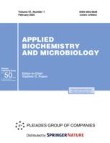|
Medicine RSS-Feeds by Alexandros G. Sfakianakis,Anapafseos 5 Agios Nikolaos 72100 Crete Greece,00302841026182,00306932607174,alsfakia@gmail.com
Πληροφορίες
Τρίτη 1 Δεκεμβρίου 2020
Bioaugmentation of Nitrifying Microorganisms to Increase the Efficiency of the Oxidation of Nitrogen Compounds during Wastewater Biofiltration
Laminin 521 Modulates the Сytotoxic Effect of 5-Fluorouracil on HT29 Colorectal Cancer Cells
|
Expression of the NADPH + -Dependent Formate-Dehydrogenase Gene from Pseudomona s Increases Lysine Production in Corynebacterium glutamicum
|
In Vitro System for the Detection of Prostate Cancer Markers via Loop-Mediated Isothermal Amplification
|
Inactivation of Yarrowia lipolytica YlACL2 gene Coding Subunit of ATP Citrate Lyase Using CRISPR/Cas9 System
|
Study of the Potential of the Reversal of the Fatty-Acid Beta-Oxidation Pathway for Stereoselective Biosynthesis of ( S )-1,3-Butanediol from Glucose by Recombinant Escherichia coli Strains
|
Construction of Recombinant Producers of Enzyme Preparations for Feed Production with an Expression System Based on Penicillium verruculosum Fungus
|
Effects of Fibroblast Growth Factor-2 and Other Microsupplements on the Productivity of IgG- and IgA-Producing Cell Lines
|
Transcriptome Analysis of Signaling Pathways in Caco-2 Cells Involved in the Formation of Intestinal Villi
|
Properties and Biotechnological Application of Mutant Derivatives of the Mini-Intein PRP8 from Penicillium chrysogenu m with Improved Control of C-Terminal Processing
|
Clusterin ameliorates tau pathology in vivo by inhibiting fibril formation
|
Cerebral organoids: emerging ex vivo humanoid models of glioblastoma
|
Αρχειοθήκη ιστολογίου
-
►
2023
(366)
- ► Φεβρουαρίου (184)
- ► Ιανουαρίου (182)
-
►
2022
(2814)
- ► Δεκεμβρίου (182)
- ► Σεπτεμβρίου (213)
- ► Φεβρουαρίου (264)
- ► Ιανουαρίου (262)
-
►
2021
(3815)
- ► Δεκεμβρίου (229)
- ► Σεπτεμβρίου (276)
- ► Φεβρουαρίου (64)
-
▼
2020
(5754)
-
▼
Δεκεμβρίου
(401)
-
▼
Δεκ 01
(25)
- Bioaugmentation of Nitrifying Microorganisms to In...
- Laminin 521 Modulates the Сytotoxic Effect of 5-Fl...
- Expression of the NADPH + -Dependent Formate-Dehyd...
- In Vitro System for the Detection of Prostate Canc...
- Inactivation of Yarrowia lipolytica YlACL2 gene Co...
- Study of the Potential of the Reversal of the Fatt...
- Construction of Recombinant Producers of Enzyme Pr...
- Effects of Fibroblast Growth Factor-2 and Other Mi...
- Transcriptome Analysis of Signaling Pathways in Ca...
- Properties and Biotechnological Application of Mut...
- Clusterin ameliorates tau pathology in vivo by inh...
- Cerebral organoids: emerging ex vivo humanoid mode...
- Successful conversion surgery of distal pancreatec...
- Beta- and Novel Delta-Coronaviruses
- Outcomes of tissue reconstruction in distal lower ...
- Prevalence and predictors of work-related musculos...
- Higher aggrecan 1-F21 epitope concentration in syn...
- Hybrid-Therapie eines Dysphagia-lusoria-Rezidives ...
- Besteht ein Zusammenhang zwischen der peripheren a...
- Infektionen in der Shuntchirurgie
- Gefäßmedizin in der ägyptischen Antike
- EUS is accurate in characterizing pancreatic cysti...
- Myocardial Perfusion Simulation for Coronary Arter...
- Adalimumab Biosimilars in the Treatment of Rheumat...
- Autotransplanted teeth including an evaluation of ...
-
▼
Δεκ 01
(25)
- ► Σεπτεμβρίου (365)
- ► Φεβρουαρίου (754)
- ► Ιανουαρίου (894)
-
▼
Δεκεμβρίου
(401)
-
►
2019
(146)
- ► Δεκεμβρίου (19)
- ► Σεπτεμβρίου (54)




